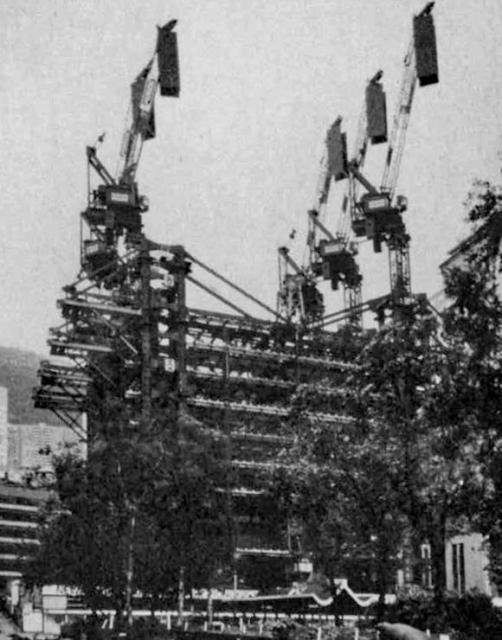The cranes used in the construction of the HSBC headquarters used 'wind-sails' on their jibs when very strong winds were expected to keep the crane aligned with the wind until the storm had passed.
Not something I have noticed in recent years on modern cranes.
Date picture taken
15 Jun 1983
Gallery
Shows place(s)

Comments
Wind sails on cranes
I hadn't heard of them before. Google to the rescue:
The big cranes on construction sites fall in to two categories: the T-shaped tower crane (AKA saddle-jib crane) where the crane's jib (arm) stays horizontal, and the luffing-jib crane shown in the photo above where the jib can be raised and lowered. A major advantage of the luffing-jib crane is that its working radius can be adjusted, which is important if it is working in a congested area. (Read more about the differences in "LUFFING-JIB CRANES VS TOWER CRANES")
When cranes aren't in use, one of the risks is that a strong wind catches them sideways-on and blows them over. Luffing-jib cranes also have a risk if the wind hits the raised jib front-on, and pushes it up and over backwards. The solution is to have the crane act like a weather vane, so it turns to point into the wind.
The T-shaped tower cranes naturally act as weather vanes: the wind exerts a stronger turning force on the long side of the jib, and the crane turns into the wind.
When a luffing-jib crane is out of use, its jib is raised as shown in the photo above. This shortens the radius of the jib, which lessens the turning force of the wind on that side. This increases the risk that the crane won't turn into the wind correctly. So to counter the effect of the reduced radius, one solution is to add sails to increase the turning force again.
All this is described in the article "A challenging angle for tower cranes", which includes a mention of the cranes used to build the HSBC building and shown above:
To extend the wind sail area in the 75 degree out of service position to its maximum, the Peiner SN 630 and SN 1000 cranes raising the Hong Kong Shanghai Bank headquarters in Hong Kong lifted up so-called Typhoon sails. These box-shaped large steel structures were lifted using the tower cranes’ hooks into the maximum lifting position. They added dramatically to the jib end surface area.